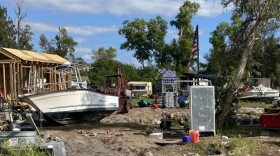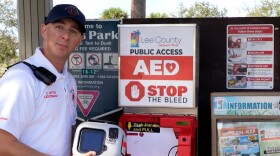Southwest Florida coastlines are undergoing a dramatic transformation. The relentless force of the ocean is devouring them. Rising sea levels paired with more frequent and powerful storms have turned what was once an escape to paradise into a glimpse of a harsh reality for locals and researchers alike.
However, a team of researchers from Florida Gulf Coast University is working to address this challenge with a unique solution.
Tristan Dumas, a senior at FGCU, and Dr. Jeannine Richards, a professor and plant ecologist at the university, have teamed up to study how different plant species can stabilize sand and rebuild dunes along Southwest Florida’s eroding shores. Their research in Lee County could provide a natural strategy to protect Florida’s coastal ecosystems and the communities that rely on them.
“Everything is happening at an exorbitant rate now,” Dumas said. “Not having any dunes or plants between the beach and somebody’s house is really the issue. You know, we can spend millions of dollars on sand every year, but it’s not going to stay there if there’s no protection to keep it there.”
The issue of coastal erosion has become an urgent concern in Florida, especially along the Gulf Coast. In 2022, the Florida Department of Environmental Protection reported that more than 22 miles of beaches in Lee County were considered “critically eroded.” These areas are quickly losing distance between the vegetation and the ocean, with every storm leaving behind less and less land.

Bowditch Point Beach on Estero Island is among the most damaged beaches due to erosion.
Strong storm surges from recent hurricanes have claimed significant portions of the beach.
However, the damage caused by these storms is not only visual. As sea levels continue to rise, the coastlines that have been a defining feature of Florida’s identity are at risk. Without urgent intervention, researchers fear the damage could be irreversible.
In hopes of helping save the Gulf Coast shoreline, Dumas and Dr. Richards began a project to identify plant species that will accumulate and retain sand in efforts to reform dunes. On a shoreline, dunes act as a natural barrier, absorbing the impact of waves.
Their research began in April 2024 at Bowditch Point, where the team installed stakes — fence posts used as reference points to track how sand moves and settles around plants over time.
“After [Hurricane] Milton, we really didn’t have enough stakes, or plants under the stakes, to show any solid data,” Dumas said. “So, we regrouped, and now we’re moving to a bigger project that will hopefully be less disturbed by hurricanes.”
In a parallel effort, FGCU student Mary Moody, a senior at the Water School, has been studying how various plant species repopulate along Lee County coastlines. Moody is working on identifying which species demonstrate the quickest growth and resilience.
“There’s an undergraduate student who I’ve been working with who planted 100 plants at different levels on Bunche Beach, and we’re observing their growth and effectiveness,” Moody said.
Lee County Natural Resources Operations Manager Steve Boutelle explained how Lee is receiving funding for the protection efforts.
He said the funding comes from a variety of sources that typically include tourist development tax revenue, as well as state funds from the Beach Management Funding Assistance Program and direct or indirect contributions from property owners.
The Florida Department of Environmental Protection publishes an annual list of critical erosion areas in the state. But it’s best for residents to leave the project to the researchers, at least for now.
“Beachgoers can help by staying off dune vegetation,” Boutelle said. “This helps stabilize the beach. It is also important to leave the beach undisturbed and cleaner than they found it.”
Fort Myers resident Madison Meyers, who frequently visits the beach, admits she didn’t fully understand the extent of the problem until it was explained.
“I moved to Fort Myers over three years ago now,” Meyers said. “I feel like over time I acknowledged a change in the length of beaches in the area, but I didn’t realize how serious this could be. I’m really surprised I haven’t heard more people in the area talking about this.”
Her reaction reflects the broader lack of awareness among many Southwest Floridians, according to researchers. They’d like community leaders to raise awareness and take action.
The potential impact of this research extends beyond Florida’s Gulf Coast. As climate change accelerates, coastal erosion is becoming a global issue. By focusing on natural restoration methods, the team at FGCU could help lead the way for global efforts to combat coastal erosion.
Researchers said they believe many types of plants work well in holding the beachfront in place. They have not found one that’s markedly better than others.
“The biggest significance we can see now is the difference between plants and no plants,” Dumas said.
WGCU is your trusted source for news and information in Southwest Florida. We are a nonprofit public service, and your support is more critical than ever. Keep public media strong and donate now. Thank you.











